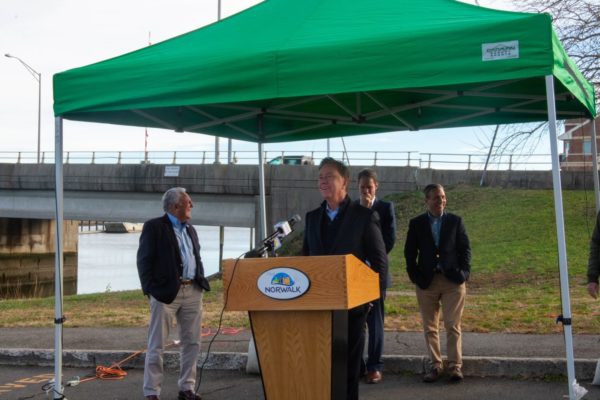Lamont, in Norwalk, talks up federal infrastructure funding to combat climate change
Gov. Ned Lamont spoke about infrastructure projects, climate resiliency, and funding from the heart of Norwalk on Dec. 17. Standing in the parking lot for the Sheffield Island Ferry, the governor was joined by U.S. Rep. Jim Himes and a number of state and municipal officials in a press conference designed to address climate change while expressing hope that the billions of dollars made available by the Infrastructure Investment and Jobs Act will mitigate the ongoing environmental crisis.
“$5 billion will come into the state of Connecticut,” Himes told those gathered when he stepped up to the podium. “It’s very important that everybody here know that in addition to being the largest investment in American infrastructure in many generations a lot of that money will be competitive. That means that the city of Norwalk and other towns and cities in Connecticut will need to understand what’s out there and available and apply for it.”

“This is a team effort,” Himes continued. “And because Connecticut sends so much money to Washington DC, we are always looking out to make sure that we get it back. So, from the governor on down, it’s really important that we all come together to look at all of these different elements of the infrastructure bill to make sure that our towns and cities get what they deserve.”
“All of us here got involved in public service because we want to make a difference,” Lamont said when he took the podium. “And a lot of the time you feel like you’re just treading water and you’re not making a difference. This infrastructure bill gives us an opportunity to make a life-changing difference, to the people of Norwalk, across the state, and across this country.”
Lamont thanked Himes for his part in passing bipartisan bill, which will distribute $550 billion nationwide, and expressed confidence that Norwalk will continue making good use of funding, which has become increasingly necessary in view of past weather events.
“You almost lost everything during Hurricane Sandy,” Lamont stated. “There were some Eversource substations, they got within a foot of rising water. If they had gone out, lights out, game over for a long time. Here we are many years later, here’s an opportunity to look at all those vulnerable spots and make sure that this never happens again.”
Lamont added that there were hundreds of millions of dollars available to aid in the construction of a grid that makes better use of wind and solar and can avoid widespread failure through the use of more localized construction and distribution. He also called on Norwalk Mayor Harry Rilling to remember that many of federal grants were being distributed on a competitive basis.
“Harry,” Lamont said, gesturing to Rilling, “we need you and all the mayors to step up. There’s $30 million in planning grants. Get to the front of the line and make sure we know that these are resilience projects that make a difference to this community.”
Lamont quipped this was necessary to make sure that the frequently flooded Water Street, located adjacent to the press conference, “is known for overlooking the water, not being beneath it.”